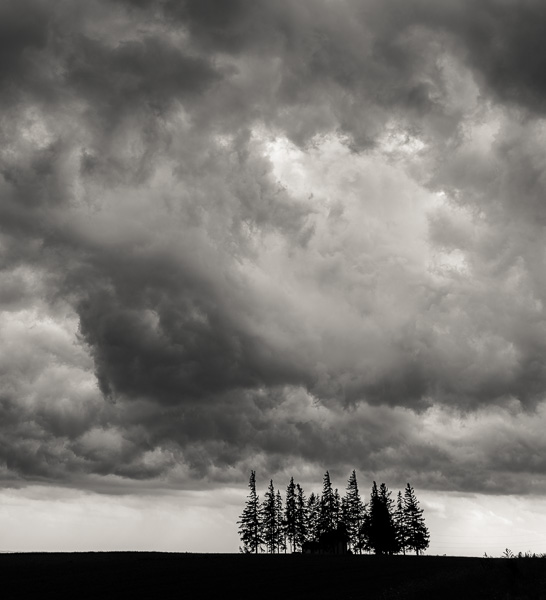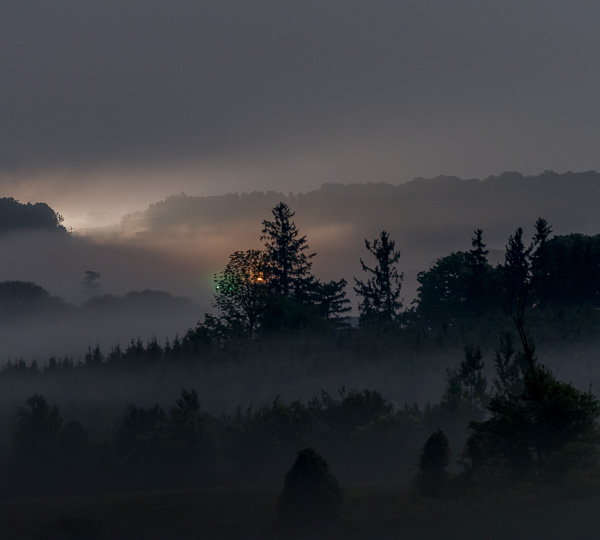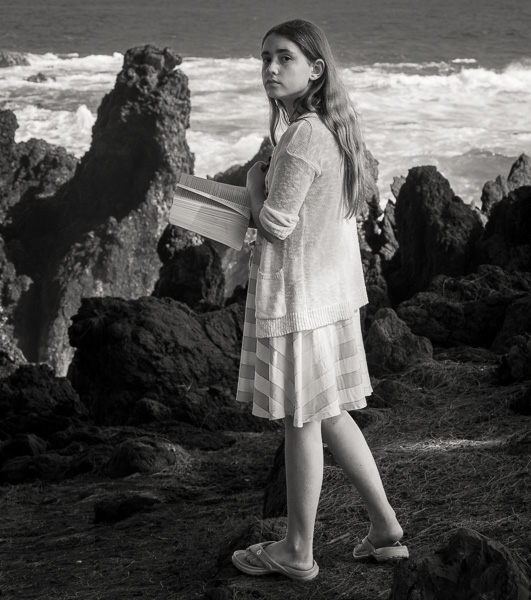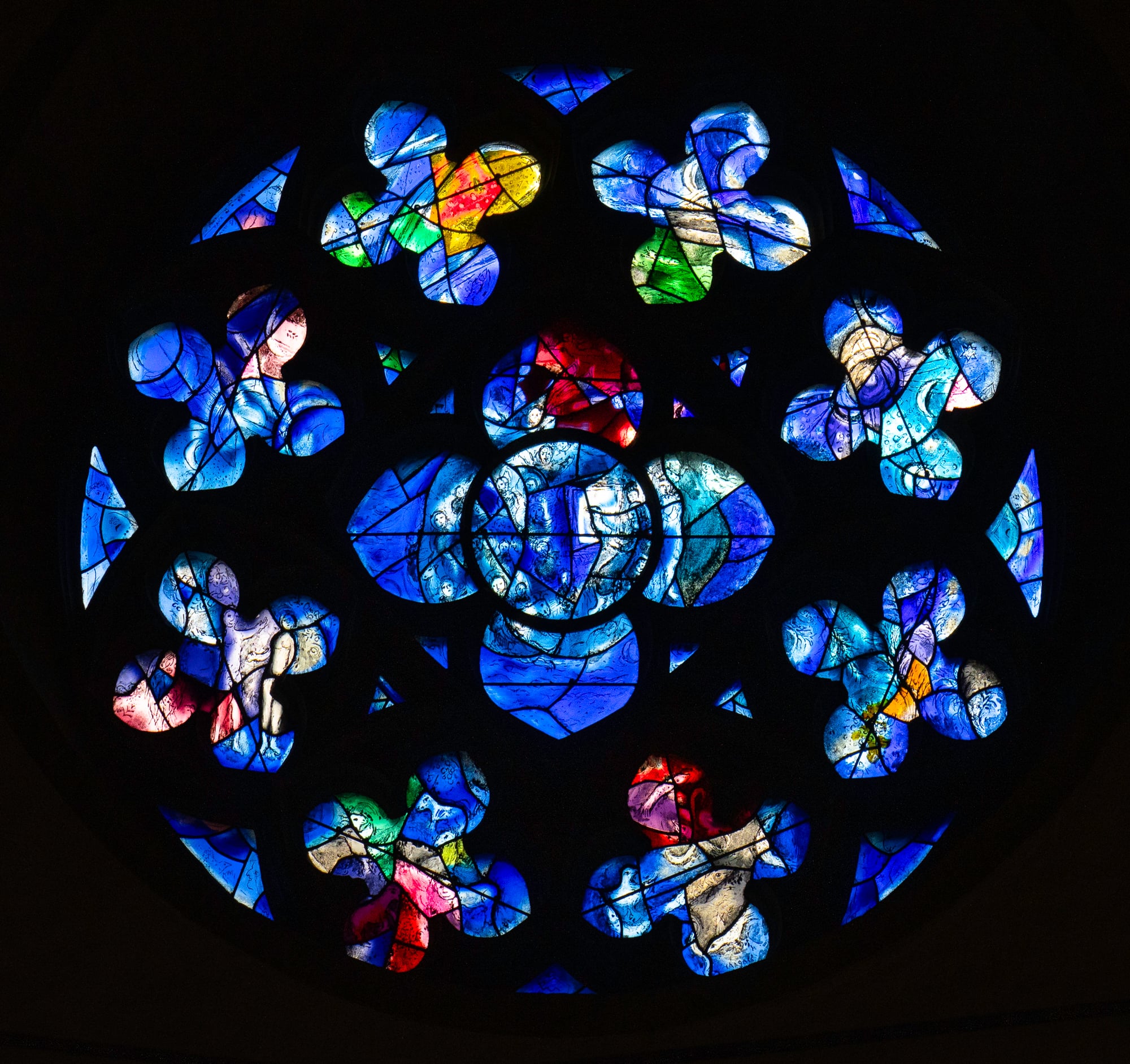Comparisons and the Odious: Fakery, Actual and Conceptual
A number of years ago I had a portrait commission that still makes me chuckle. I was asked to make a family portrait of a single mother and her three grown daughters, all of whom were unusually attractive and independent ladies from Texas. The youngest daughter, who might have been the most beautiful of them all, had just gotten married, to an earnest and ambitious suitor whom I’ll call Fred. The five of them were to be the subjects of the portrait.
I set up my lights on the mother’s veranda, and began playing with various arrangements of poses. Spirits were high and the banter was flowing. At one point, one of the daughters mentioned a friend of hers who had had occasion to airbrush an ex-husband out of the family picture, and she suggested that Fred might go in the back and towards the outside edge, just in case her sister’s marriage didn’t work and he ever had to be airbrushed out. This provoked gales of laughter, in which Fred manfully joined.
Well, the four women didn’t want to let this capital joke drop, and kept elaborating on it until they’d worked themselves into a state of high hilarity. Fred’s laughter, of course, grew increasingly anemic, and he began to sprinkle in some weak protests. But the really funny part is that they actually did insist that Fred go on the back and towards the outside.
So my finished picture, try though I might, featured four lovely women flushed with laughter and sporting toothsome grins, and a quite bewildered and crestfallen Fred…in back, and in a position where the four remaining subjects would look good were he ever removed.
Similarly, my friend Becky tells a story of an ex-boyfriend whom she clipped out of a large family portrait with nail scissors. She said that her mother, thus encouraged, expertly clipped the photograph in two, snipped and trimmed some more, and slid the two ends together, which closed up the gap where the boyfriend had once been. She said the surgery worked so well that it was difficult to tell, without looking closely, that the picture had ever been altered.
Propaganda has its uses
Of course, there are many instances in the history of photography of people fudging, faking, or otherwise editing photographs to change the apparent reality, sometimes for the sake of humor. We’re all aware of old postcards featuring a twenty-foot long trout or tomatoes the size of beach balls on horse-drawn wagons, or grinning tourists playing a trick of perspective and holding up the leaning tower of Pisa with an outstretched hand. Anyone who has read Edward Weston’s Daybooks knows how often, and how bitterly, he complained of the drudge-work of retouching portrait negatives to get rid of clients’ wrinkles and blemishes.
Sometimes the intentions of the fakers is more sinister. David King, in his book The Commissar Vanishes, documents just how routinely purged Soviet leaders were retouched out of the photographic record; the CIA used to exhaustively examine such photographs to learn who was in favor at any particular time, and who wasn’t, in the old Soviet hierarchy. Unfortunately for the individuals involved, the newly missing were also often the newly executed.
But what is truth? Some fairly egregious rearrangements of photographic reality have been justified for allegedly "artistic" reasons. There are a number of instances where even news photographs are altered. One notorious example was Matt Mahurin’s TIME magazine cover made from O. J. Simpson’s mugshot, a "photo illustration" that was widely criticized for making Simpson look more heavily bearded and darker-skinned than he looks in the actual mugshot. What is less often noted is that TIME may have gotten away with it but for the fact that NEWSWEEK ran the same mugshot on its cover, unaltered, that same week.
In fact, it’s usually only by making direct comparisons that changes can be detected. Some folks, "Where’s Waldo" style, make a game and a pastime of doing this. More power to ’em, if fakes are thereby detected and newsrooms kept more honest.
In fact, it is magazine covers that are probably the most high-profile culprits. As anyone who’s ever edited a magazine knows all too well, cover design is a black art and a constant source of strain and tension. Joe Zeff, of Joe Zeff Design, says, "Consider the damage inflicted upon a photograph that is chosen to appear on a magazine cover. First it must be tightly cropped to maximize its impact on the newsstand. Next the logo is placed at the top, obscuring about 20 percent of the image. A headline is added, as well as a subhead, as well as one or more teasers, sometimes with a smaller photograph of its own. Finally, the bottom corner is compromised by a mailing label or a UPC code. Not every photograph can withstand that kind of torture." (Quoted by Kenneth F. Irby at Poynteronline.) Magazines alter pictures most often simply because magazines more often run type on top of pictures. Things have to be massaged in order to fit together.
The punditocracy has so far produced no shortage of maundering about the contribution made to all this by the advent of digital imaging andAdobe Photoshop. Really, though, this fits my general thesis that digital is a technological revolution but conceptually only a less significant evolution: digital fakery and manipulation are just one more sideways shuffle along the same old continuum. Digital makes fakery and alteration easier to do and tougher to detect, but then, those two things have both been slip-sliding along more or less progressively since 1839. The ethics of it all are still just as murky as ever. Bruce Goldfarb has an excellent online article athttp://larrysface.com/deception.htmthat shows many actual examples. He shares some good links, too.
What’s the frequency, Kenneth?
It has often been argued that consumers are "media-savvy" enough to know that pictures might not be literal records. This, of course, is an excuse that is highly appealing to us consumers — by which I mean you, reading this right now, and me — since of course each of us likes to believe that we are indeed savvy, perceptive, and tough to fool. But, actually, I’d argue the opposite. In this early election season, both Kerry and Bush have played fast and loose with the facts in their television ads, especially Bush (and no, that’s not an editorial comment, it’s just plain old truth). Research has showed that although people say they are not affected by these falsehoods, actually they are, because when questioned about their beliefs in greater detail, they cite factoids that appear nowhere else but in the TV ads.
In the same way, I think that pictures that lie do tend to influence our vision of the world. One of the striking aspects of Michael Moore’s propaganda documentary Fahrenheit 9/11 is that he shows the dead, dying, and grieving on both sides, aspects of this war that have been largely censored by our government. Are we fooled by the censorship? We may like to think we aren’t, but I believe we are, at least subliminally. Americans believe this war is somehow more antiseptic than others, as though people are not being slaughtered and maimed as they inevitably are in any war.
Early in my career atPhoto Techniques, I got into hot water by writing, under a pseudonym, a brief rebuttal of an author who was presenting composite landscapes. I did it to fill a column left vacant by an 11th-hour withdrawal of an ad, but it was wrong of me — I was unfairly subverting that author’s presentation, without allowing him to respond or react, and an editor should be an advocate for his or her authors, not an antagonist. I hope I learned from my mistake, restricting my editorial comments to the editorial column from then on. But the fact remains, I really do abhor composite images that are subtle enough to fool you into thinking they’re real. I object to them ethically, but I also object to them intellectually. It’s something I learned from my friend the photography writer Ctein, who told me he feels that all the photographs he’s ever seen, in the aggregate, teach him how the world really looks, and that fake photographs distort and undermine that basic educational function. In other words, it may be okay for a scenic to be pretty, but I tend to want it to be at least honest as far as it goes.
Even distortions of emphasis can be seen as lies. I overheard a guy at the Wal-Mart the other day disparagingly refer to a display of Bill Clinton’s new biography by saying it ought to be titled "My Lie." While that may be a bit harsh coming from a guy who hadn’t read the book, there’s no question that autobiography reorders things by emphasizing and de-emphasizing. A few days later, articles popped up reporting that Monica Lewinsky strenuously objected to Clinton’s portrayal of their affair, which, she felt, treated her as a mere cypher. Her argument virtually proves itself by the fact that she merits only a few lines in a nearly 1,000-page book. (Of course, she’s written her own autobiography.) So is Clinton lying about that aspect of his life? Maybe not directly, but by implication and omission, yes.
As far as this same thing manifests itself photographically, consider my lifelong whipping boy, the travel pictorial. You can see them in any discount book store — shelves full of picture books with place names: Ireland, Greece, Vermont, etc . Crack open any one of them and flip through however many pages you can stand; what you’ll get is little apart from a sanitized official view of the area’s formally picturesque places and scenes: its famous landscapes, noble old buildings, historical sites, and conventional clichés. Is there any pictorial book of Vermont that doesn’t include idyllic scenes of sap buckets on maple trees or Strafford’s Paul Strand church, or any book about Ireland that doesn’t feature at least one Glendalough ruin or adorable smiling red-haired tinker imp with no snot in its nose? The same books seldom feature lovingly-rendered pictures of unkempt alcoholics on the street or rural house trailers with dismantled washing machines out front.
The litmus test of the unreality of a travel book comes from, well, actually traveling to that place, and comparing the book version to what the place actually looks like. I was lucky enough to get to do a lot of traveling early in my life, so when I saw travel books called France or Rome or The Bahamas, I actually knew what those places looked like. The vision presented by the travel book, often as not, was nearly unrecognizable.
The same argument, however, might also be posited in reverse. In a certain "documentary" tradition, only the gritty and the low are featured, and never anything beautiful. You might say that such views are only the antithesis of the pretty and the antiseptic, showing only the ugly and the toxic.
Are any such books justified as argument? Probably so. That is, they’re making a case for one type of interpretation, not trying to present an accurate, unbiased picture. I suppose some people do travel to distant locations just to look at the standard "sights," and they don’t let themselves really "see" the rest of what’s there.
Still, the occasional book does come along that treads the middle ground, showing the lyrical and beautiful in a purely realistic, unsentimental context. One such book is David Hurn’s Wales: Land of My Father, which is a pure and cold-eyed documentary but nevertheless a deeply affectionate portrait. Perhaps this should come as no shock, considering that Hurn, along with co-author Bill Jay, wrote a book that’s a photographers’ favorite, LensWork Publishing’s On Being A Photographer. Hurn’s pictures surely possess the "slap of truth," but something like the white foal in "Black Mountains" is undeniably beautiful by anyone’s definition.
Color me hardcore
I’m a fundamentalist when it comes to truth in photographs. I think all pictures ought to be as true as possible, and that the only excuse for manipulation, beyond "fixing" the photograph technically, are changes meant to make it subjectively more truthful to the photographer’s perception of the subject. Changes for the sake of fit, "illustration," decoration, or eye appeal make pictures not better photographs, but merely less photographic.
— Mike Johnston
Newsletter Update:
Issue number 6 of my newsletter "The 37th Frame" has been published, the first to be delivered in .pdf format. The response has been overwhelmingly positive so far. It’s 33 pages long (nice big readable type), with 8 illustrations, about 520k in size. It contains the answers (and the questions, too!) to the "Photo Culture Pop Quiz," a brief reflection about photography’s "first principles," an article about a crucial but often overlooked aspect of print preservation, a greatly extended article about CD-R archivalness following up on the SMP column about the same subject several weeks ago, and an expanded news section (with pictures!), among much else.
I have so far delivered the issue to about one-fifth of the newsletter’s 1,250 total subscribers, and am making progress delivering more in as much of my spare time as I can devote to the process. If you’re a subscriber and you haven’t gotten yours yet, hang tough, and don’t despair. I’m creeping my way down the list virtually every day, addressing problems as they arise. I want the new database to be correct, and SNAFU-proof, from the start (fool me once…). It may stretch out the delivery of this first .pdf edition, but it will greatly streamline subsequent deliveries.
One thing I wasn’t able to get done is Part II of the 35mm lens reviews, which will be in Issue #7 along with the extended version of "Parameters of Lens Specification and the Properties of Lenses." 35mm lenses reviewed will be the Leica 35mm ƒ/1.4 Summilux-M Aspherical (Type 1), Leica 35mm ƒ/2 Summmicron-M ASPH., Pentax Super-Multi-Coated Takumar 35mm ƒ/2 M42 screwmount, AF-Nikkor 35mm ƒ/2, Leica 35mm ƒ/2 Summicron-R, Pentax SMC Pentax-M 35mm ƒ/2, and Zeiss Contax Distagon 35mm ƒ1.4. It will also contain my nomination for the single best lens made for photography, which is kind of a silly exercise but kind of fun nevertheless. So I guess Issue #7 will be "the lens issue."
See Mike Johnston’s website atwww.37thframe.com. Also, check out his monthly column in the BritishBlack & White Photographymagazine! (Usually available at Barnes & Noble bookstores.)
Want to read more? Go to the SMP Archives
Mike Johnstonwrites and publishes an independent quarterly ink-on-paper magazine calledThe 37th Framefor people who are really "into" photography. His book,The Empirical Photographer, has just been published.
You can read more about Mike and findadditional articlesthat he has written for this site, as well as aSunday Morning Index.
Read this story and all the best stories on The Luminous Landscape
The author has made this story available to Luminous Landscape members only. Upgrade to get instant access to this story and other benefits available only to members.
Why choose us?
Luminous-Landscape is a membership site. Our website contains over 5300 articles on almost every topic, camera, lens and printer you can imagine. Our membership model is simple, just $2 a month ($24.00 USD a year). This $24 gains you access to a wealth of information including all our past and future video tutorials on such topics as Lightroom, Capture One, Printing, file management and dozens of interviews and travel videos.
- New Articles every few days
- All original content found nowhere else on the web
- No Pop Up Google Sense ads – Our advertisers are photo related
- Download/stream video to any device
- NEW videos monthly
- Top well-known photographer contributors
- Posts from industry leaders
- Speciality Photography Workshops
- Mobile device scalable
- Exclusive video interviews
- Special vendor offers for members
- Hands On Product reviews
- FREE – User Forum. One of the most read user forums on the internet
- Access to our community Buy and Sell pages; for members only.













